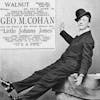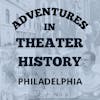Hello, and Welcome once again to Adventures in Theater History. This week we have what we term a Special Episode, because it is not strictly my own work. Instead, it’s going to be me reading directly from one of my favorite Philadelphia history books: Wicked Philadelphia, Sin in the City of Brotherly Love by Thomas H. Keels, published by the History Press in 2010. As you’ll hear, our friendly neighborhood sound designer, Chris Colucci, has added in extra music and sound effects, so I think between us we’ve done a lot to bring this great story to life, as a podcast presentation.
Thomas H. Keels is a lecturer, writer, and historian specializing in Philadelphia history and architecture. In addition to Wicked Philadelphia, he has also written Forgotten Philadelphia: Lost Architecture of the Quaker City; Philadelphia Graveyards and Cemeteries; Philadelphia’s Rittenhouse Square; and Sesqui! - Greed, Graft, and The Forgotten World's Fair of 1926.
In addition, Tom has been a tour guide at Laurel Hill Cemetery, Philadelphia's premier Victorian necropolis, for over two decades now. I was introduced to Tom by Joe Lex, who does the great podcast “All Bones Considered”, which covers the stories of all the fascinating people who ended up being interred at either Laurel Hill or West Laurel Hill Cemeteries. I recommend you check out both Tom’s books and Joe’s podcasts, and that if you’re in Philadelphia, you add to the list of things to do - taking a cemetery tour among the marble mausoleums with either one of these gentlemen. They’re really cool guys.
In his book Wicked Philadelphia, Keels covers many of the seamer sides of Philly history, including prostitution, murder, fraud - and in fact there is a very fine chapter on strange story how the body of the actor John Barrymore finally came home to its final resting place in Philadelphia - something I hope to cover in a future bonus episode for our supporters on Patreon. Tom has very generously agreed to let me use the text of his book today, and I’m very grateful for him for his kindness, as well as for his deep scholarship and excellent writing.
The chapter I am reading today is called “Oh It’s A Lovely War! The Mischianza,1778”. So although we’ve been making forays from the 19th century into the 20th century in some of our episodes lately, this story shifts back and forth between the 19th Century and the 18th Century - the Revolutionary War period, in fact, an era we haven't really covered since about Episode 4.
This story isn’t about plays that were staged in theaters, it's about a grand pageant. So it falls rather under the broad category of para-theatrical activity. Along with our previous exploration about circuses and parades, it is all part of the larger story of performance traditions and public display in Philadelphia, and it also has been examined by many theater historians as one of the earliest examples of blackface portrayal in the record. It’s also just a ripping good tale, and before we move on to the twentieth century in the months ahead, I thought we should go back and cover it.
Once again, these are all Thomas Keel's words. I love this chapter so much, I couldn’t possibly improve on either his research or his writing, but I hope you’ll enjoy our rendition of “Oh It’s a Lovely War! The Mischianza”
[TEXT OF CHAPTER NOT TRANSCRIBED. ALL TEXT COPYRIGHT THOMAS H. KEELS. Auto recorded and shared by permission of the author.]
So, that’s the end of the chapter. The book it is from, Wicked Philadelphia: Sin in the City of Brotherly Love by Thomas Keels, is available on Amazon.com. Please visit Tom's website, www.thomaskeels.com, for more information on his other books and upcoming talks and lectures. I’ll put a link in the show notes.
Tom tells me, by the way, that the Chew home in Germantown is often pronounced “Cliv-den”, just like its namesake, the huge manor house in Buckinghamshire, England. Even though the Philly Cliv-den is found on “Cliveden Street” - a little local trivia, there.
I’ll add, just for general interest, that Major Andre, as it mentions in the chapter, often put on plays and participated in theatricals at the South Street or Southwark Theatre that we’ve talked of before. And that in fact he had painted scenery for them, and that scenery was in the collection of the theater for decades thereafter and was proudly shown off for many plays presented in Philadelphia. The scenery, of course, was lost in the 1821 fire that destroyed the South Street theater. Tom Keels tells me, however, that there is a picture of a grenadier painted by Andre (either as a prop for one of the plays or for the Mischianza) at the Germantown Historical Society.
Thanks so much for listening to this Special Episode. I hope you enjoyed listening, as much as I enjoyed reading it. I’ll see you again next time, when we will be bringing you the story of John Arneaux: The Black Booth! It will be another thrilling Adventure in Theater History: Philadelphia!









